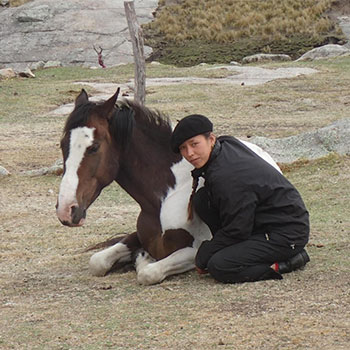
Yancen Diemberger
I have always been curious about human-environment interactions and fascinated by inter-species communication. Born in the Italian Prealps to Tibetan/Austrian parents, I grew up in the English Fens and was brought up playing with languages in different contexts and ways. While working on environment-related local narratives in the Himalayas, I came across a range of living horse cultures as well as a Tibetan manuscript which describes horse breeding and medicine (an illustrated compilation tentatively dated to the 18th century, which includes texts from as early as the 9th century). Fascinated by the characteristics attributed to the horse by the manuscript, I began investigating and translating the text. This preliminary research led to and co-authored introductory paper to the manuscript, which I presented at TibSTAT in Paris during my final year of studies in “Languages and Cultures of South Asia and Tibet” at Vienna University.
I subsequently developed a PhD research project in anthrozoology that aims to explore how the different cultural dynamics within which the horse is embedded reflects on practical elements of equitation. This research interest built on my undergraduate work and my experiences from when I decided to follow a childhood dream which took me from Chile northwards to Panama, working in various horse-related placements. Just as I started to feel ready to come back, an unexpected turn of events re-directed my travel route to Argentina, where a temporary job ended up becoming a way of life. Experiences among different horses, people, disciplines and environments brought to light how comparable experiences of human-animal relations can be encoded into different cultural narratives. Captivated by the horse-human relationship in a practical sense, as well as its variations within different cultural contexts, I decided to pursue my curiosity academically.
My research “To speak horse in the Himalayas and Argentina: to what an extent does communication between humans and horses depend on a “language”, and how does it differ in different cultural contexts?” combines these factors and experiences. It examines notions of horse “sentience” in a cross-cultural analysis and questions how these notions effect horse-human communication. More specifically, it analyses the construction of an inter-species “language” based on the “consciousness,” “perception,” and “discriminative cognition” that both species, are at times, attributed.
